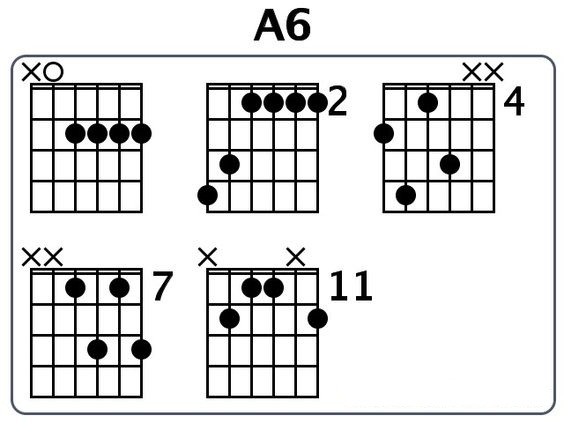The A6 chord is a beautiful, versatile addition to any guitarist’s repertoire. Whether you’re a beginner or looking to expand your chord knowledge, the A6 chord is simple to play and sounds rich and full. In this post, we’ll break down how to play the A6 chord, its variations, and how to use it in different musical contexts.
What is the A6 Chord?
The A6 chord is a major chord with an added 6th note. It’s essentially an A major chord with the 6th note from the A major scale. The notes in an A major scale are A, B, C#, D, E, F#, and G#. The 6th note in this scale is F#, so when you add this to an A major chord, you get the A6 chord. This gives it a slightly jazzier, fuller sound compared to the basic A major chord.
How to Play the A6 Chord
Here’s the standard way to play the A6 chord:
- Place your index finger on the 2nd fret of the D string (4th string).
- Place your middle finger on the 2nd fret of the G string (3rd string).
- Place your ring finger on the 2nd fret of the B string (2nd string).
- Let the A string (5th string) ring open.
- Do not play the low E string (6th string).
This gives you the notes: A (open A string), E (2nd fret on the D string), F# (2nd fret on the G string), and C# (2nd fret on the B string).

A6 Chord Variations
Like many guitar chords, the A6 chord has variations that you can use depending on the musical context or your preference for a different sound. Here are a couple of other ways to play the A6 chord:
Barre Chord Variation
If you’re comfortable with barre chords, you can play the A6 chord by barring the 2nd fret with your index finger. Here’s how:
- Bar the 2nd fret across all the strings with your index finger.
- Place your ring finger on the 4th fret of the A string (5th string).
- Place your pinky on the 4th fret of the D string (4th string).
This gives you the same A6 sound but allows for a fuller chord across all strings.
A6 Chord in Open Position
For an open position version, you can play the A6 by:
- Place your index finger on the 2nd fret of the D string (4th string).
- Place your middle finger on the 2nd fret of the G string (3rd string).
- Let the A string (5th string) ring open.
- Play the open E string (1st string), which adds a nice high F# note to the chord.
Using the A6 Chord in Music
The A6 chord can be used in many genres, from pop to jazz to folk. It’s a great way to add some color and warmth to a song. Here are a few ideas:
- In Pop Music: The A6 chord can work well in pop songs that have a rich, harmonic sound. It can be used in progressions like A6 – D – A6 – E.
- In Folk Music: The A6 chord adds a bit of complexity and smoothness to typical major progressions. Try using it as a passing chord, such as in A – A6 – D.
- In Jazz: Jazz musicians love adding the 6th to chords for a more sophisticated sound. In jazz, you might see A6 in progressions like A6 – G#m7 – C#7.
Conclusion
The A6 chord is a simple yet beautiful chord that adds a unique flavor to your guitar playing. Once you master it, you’ll find that it opens up new possibilities in your music, whether you’re playing folk, pop, or jazz. With practice, you’ll be able to seamlessly incorporate the A6 chord into your chord progressions and songs. Keep experimenting and enjoy the richness it brings to your music!